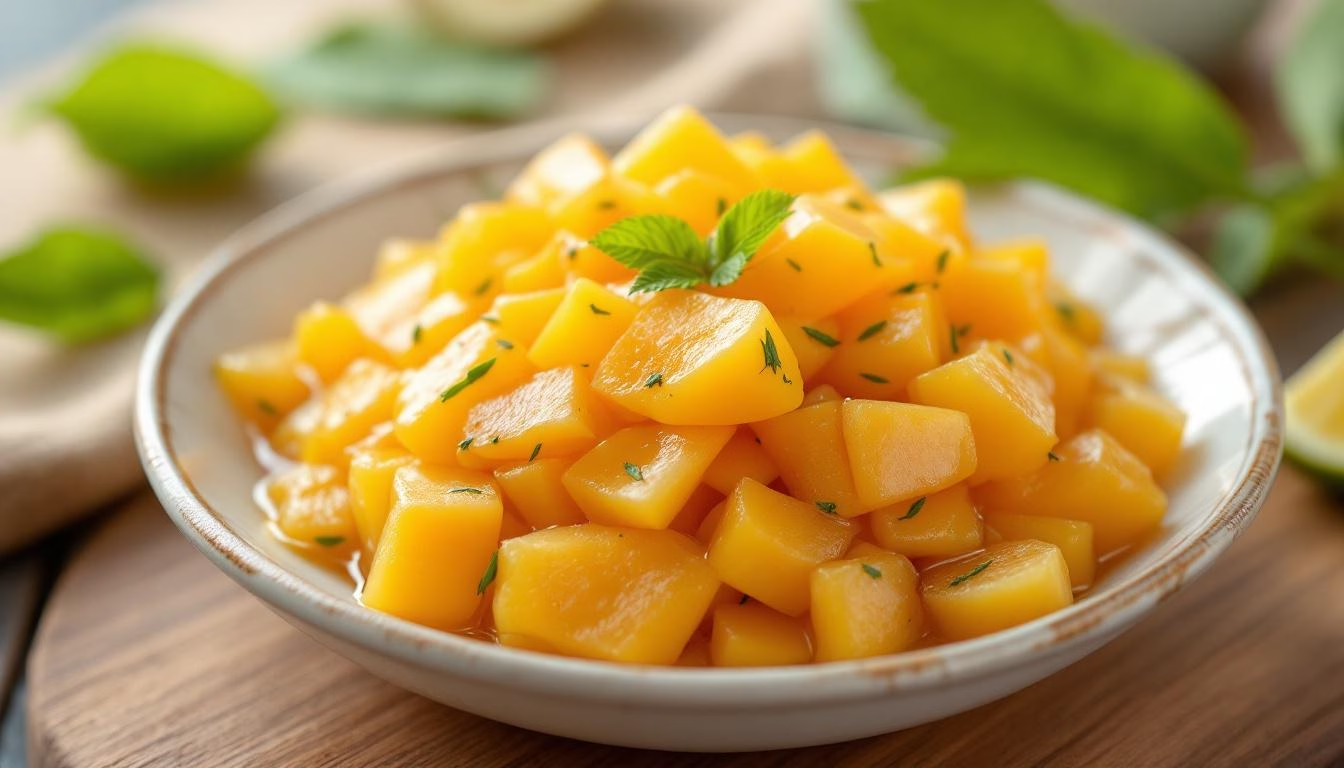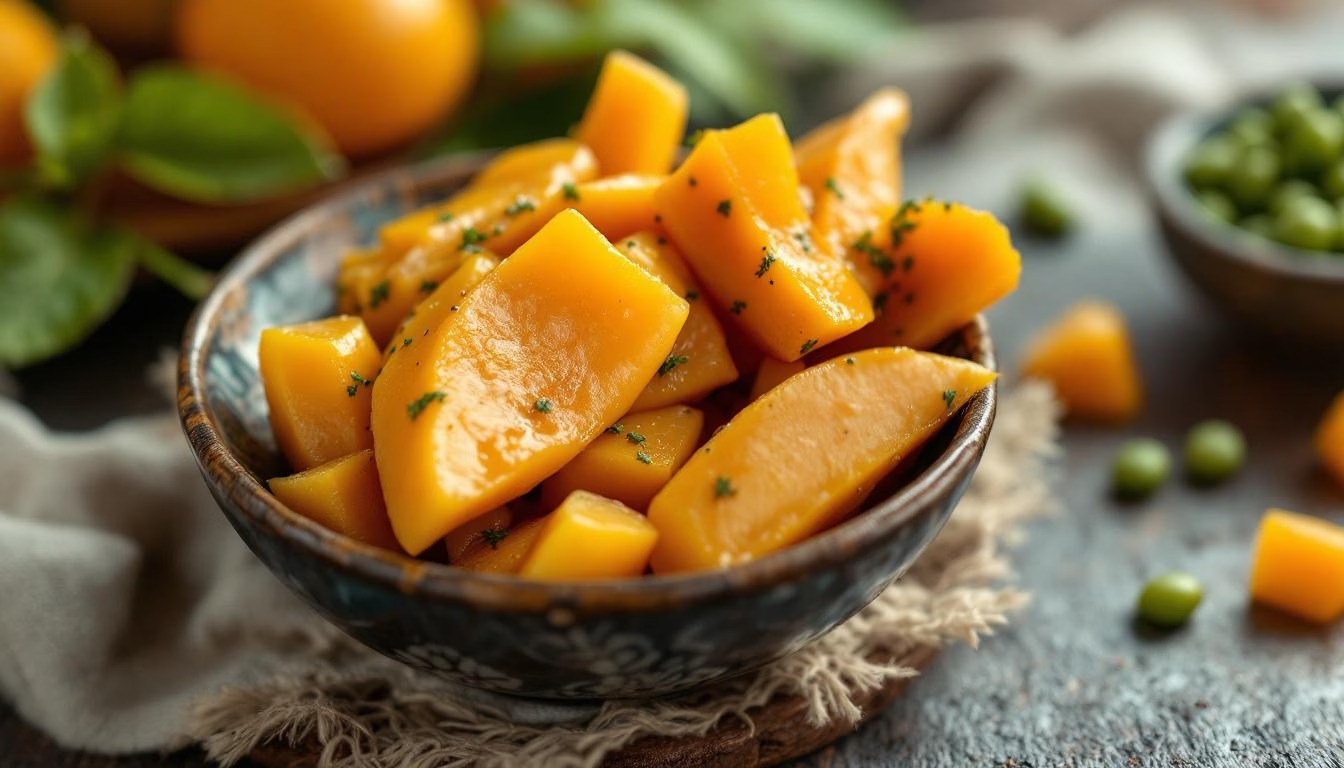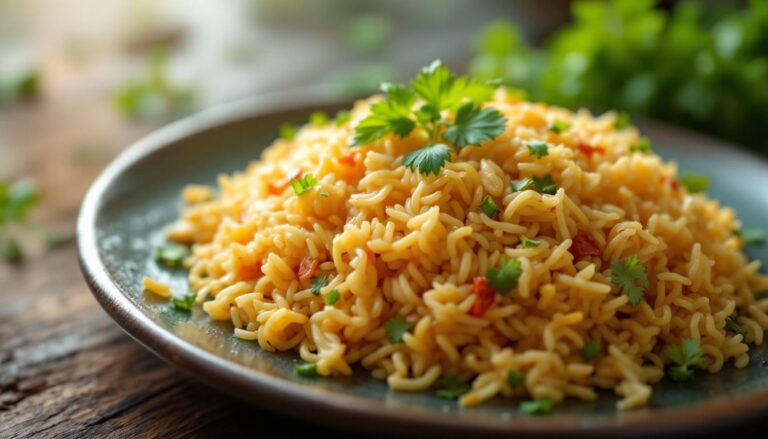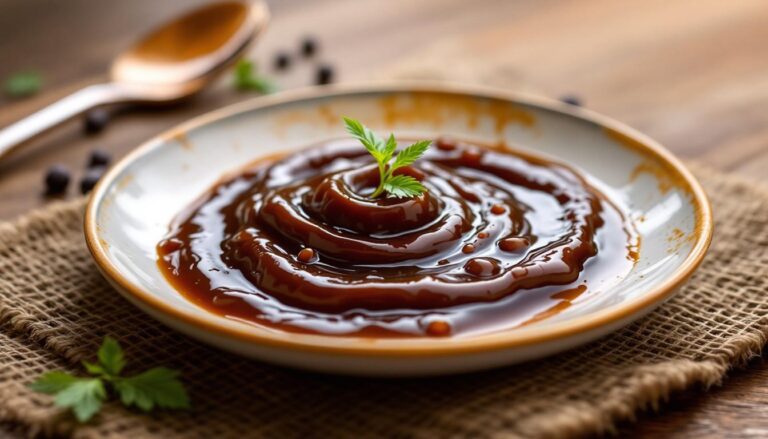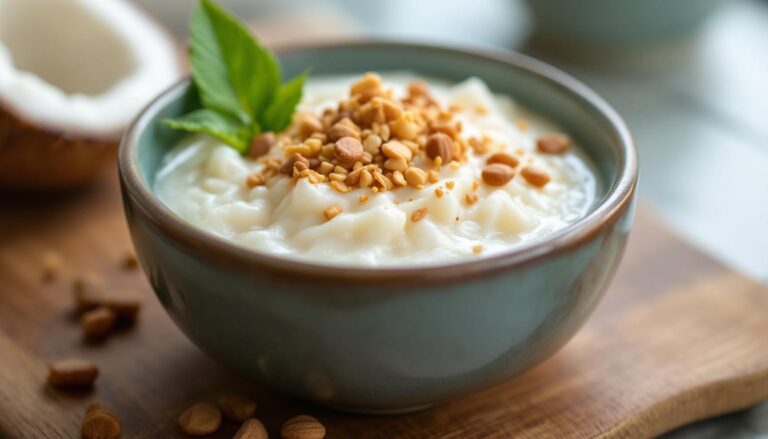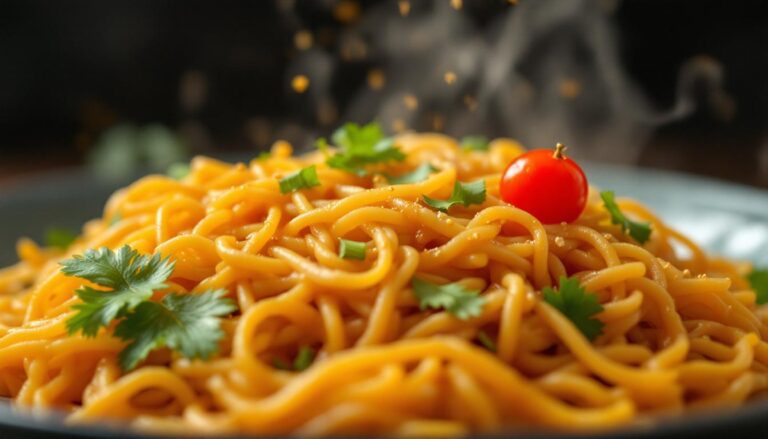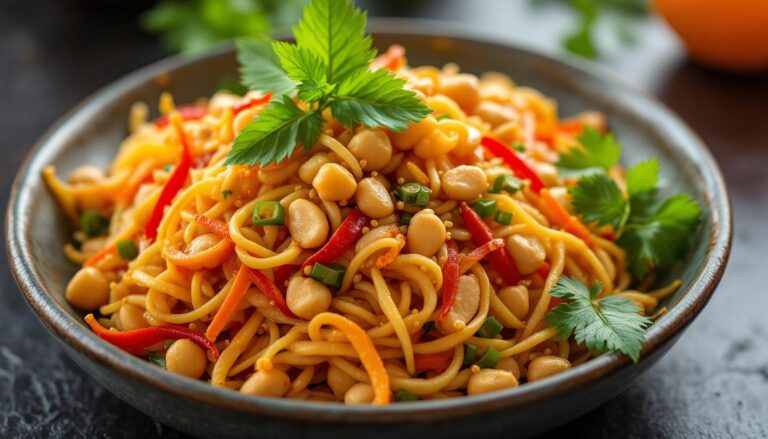Javanese Asinan Buah Indonesian Pickled Mango Recipe
Spicy-Sweet Javanese Asinan Buah Recipe: The Ultimate Green Mango Pickle – I used to be one of those people who turned their nose up at fruit salads with anything more adventurous than a squeeze of lime.
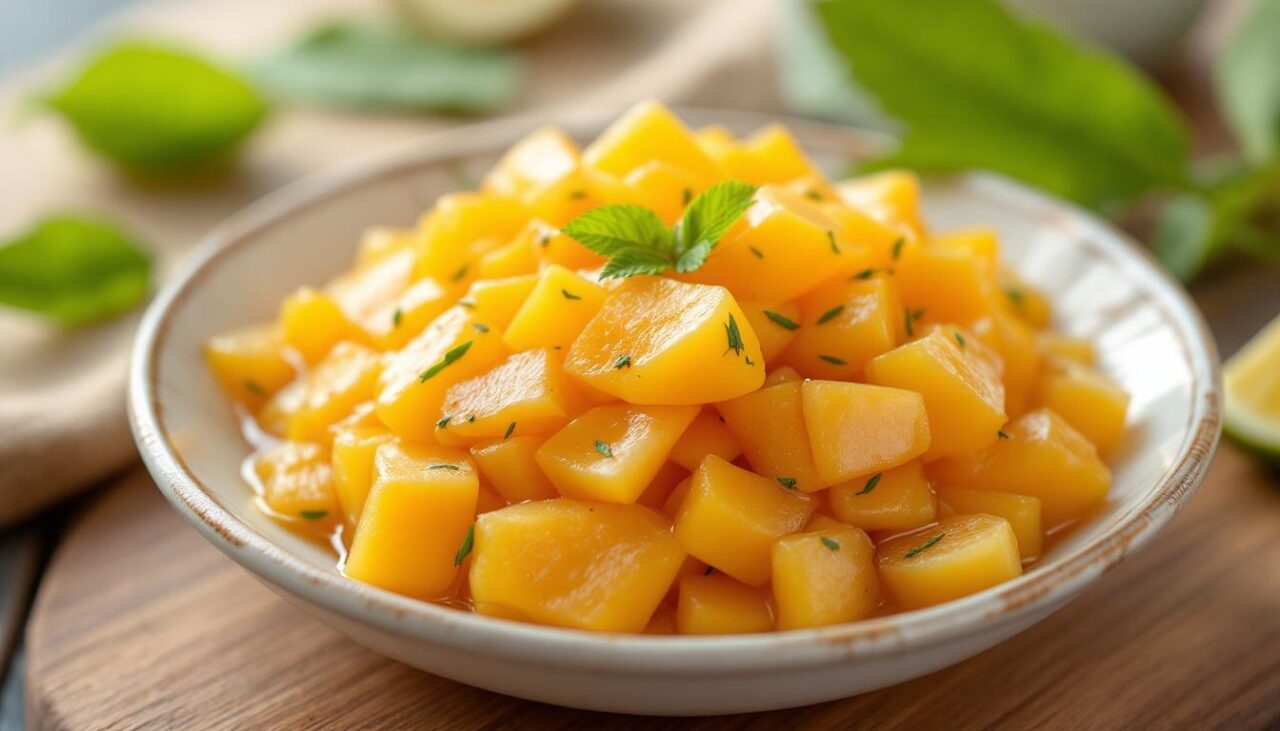
Javanese Asinan Buah (Indonesian Pickled Mango from Bogor)
Ingredients
- 2 green mango (unripe mango, peeled and cut into bite-size wedges)
- 1 Persian cucumber ((or ¼ English cucumber) peeled and sliced, or wedge-cut)
- ½ cup jicama (peeled and julienne cut)
- 2 bird’s eye chilies (stem removed)
- 1 Fresno chili ((or Korean Chili or Cayenne pepper) stem removed)
- 2 cloves garlic
- 2 tablespoons palm sugar (coconut sugar or brown sugar)
- ½ teaspoon salt
- ⅓ cup white vinegar
- 2 cups water
- Fried peanuts
- Fried shallots
- Cilantro leaves
Instructions
- Peel 2 unripe green mangoes and cut into bite-size wedges. Peel and slice 1 Persian cucumber. Julienne the jicama. Place everything in a medium bowl.
- Combine birdu2019s eye chilies, Fresno chili, garlic, sugar, salt, white vinegar, and water in a blender; blend until smooth and tangy.
- Pour the blended mixture into a saucepan and bring it to a boil.
- Pour the hot brine over the fruits and vegetables to coat evenly, then toss gently to combine.
- Let the mixture cool and marinate for at least 2 hours to allow the brine to penetrate.
- Just before serving, garnish the Asinan Buah with fried peanuts, fried shallots, and fresh cilantro leaves.
Nutrition
Sweet fruit belonged with sweet things, I reasoned, and the idea of dousing perfectly good mango in chili and vinegar seemed like culinary chaos.
Then I met my Indonesian friend Sari, who invited me to a street food crawl through her neighborhood in Queens, and everything I thought I knew about fruit got turned deliciously upside down.
We stopped at a tiny cart where an elderly woman was methodically arranging pale green mango wedges, cucumber slices, and strips of something I couldn’t identify in clear plastic containers.
Sari ordered two portions of “asinan buah” and watched my face as I took my first tentative bite.
The explosion of flavors was immediate and completely unexpected—the sharp tang of vinegar, the gentle heat of chilies, the earthy sweetness of palm sugar, all playing against the crisp, slightly tart mango.
It was refreshing in a way that made my mouth water for more, and I found myself finishing the entire container while standing on a busy sidewalk, marveling at how wrong I’d been about pickled fruit.
That first taste of Javanese Asinan Buah (Indonesian Pickled Mango from Bogor) recipe was a revelation that sent me down a rabbit hole of Indonesian street food research.
I pestered Sari with questions, watched YouTube videos of street vendors in Jakarta, and eventually convinced her to teach me her grandmother’s version—which, she assured me with a laugh, was “nothing fancy, just the way we’ve always made it.”
Indonesian Pickled Mango: Authentic Bogor-Style Asinan Buah Recipe
Asinan buah, which literally translates to “pickled fruit,” is one of Indonesia’s most beloved street snacks, and the Bogor-style version holds a special place in the hearts of Javanese food lovers.
Bogor, a city in West Java known for its cool mountain climate and abundant fresh produce, has perfected this particular style of fruit pickle that balances sweet, sour, salty, and spicy in perfect harmony.
What makes this Javanese Asinan Buah (Indonesian Pickled Mango from Bogor) recipe particularly special is its use of unripe green mango—the kind that’s firm, tart, and holds its shape beautifully when dressed in the tangy brine.
Unlike the soft, sweet mangoes we’re used to eating fresh, green mangoes have a crisp texture similar to a firm apple and a pleasantly sour flavor that actually improves with the addition of chili and vinegar.
The beauty of asinan buah lies in its simplicity and its ability to transform humble ingredients into something extraordinary.
Street vendors across Indonesia have been perfecting variations of this recipe for generations, each adding their own touch—some prefer more heat, others lean into the sweetness of palm sugar, and many have secret ingredient combinations passed down through families.
The Bogor style specifically emphasizes the interplay between the hot brine and cool, crisp vegetables, creating a refreshing snack that’s perfect for Indonesia’s tropical climate.
Making Your Own Javanese Asinan Buah at Home
The wonderful thing about this Javanese Asinan Buah (Indonesian Pickled Mango from Bogor) recipe is that it requires no special equipment and uses ingredients you can find at most Asian markets (and increasingly, regular grocery stores).
The technique is straightforward, but like many simple dishes, the magic is in the details—the right balance of sweet and sour, the proper texture of the vegetables, and most importantly, giving the flavors time to meld together.
Ingredients You’ll Need For This Asinan Buah Recipe
For the fruit and vegetables:
- 2 green mangoes (unripe mango, peeled and cut into bite-size wedges)
- 1 Persian cucumber (or ¼ English cucumber, peeled and sliced or wedge-cut)
- ½ cup jicama (peeled and julienne cut)
For the brine:
- 2 bird’s eye chilies (stem removed)
- 1 Fresno chili (or Korean chili or cayenne pepper, stem removed)
- 2 cloves garlic
- 2 tablespoons palm sugar (coconut sugar or brown sugar work as substitutes)
- ½ teaspoon salt
- ⅓ cup white vinegar
- 2 cups water
For garnish:
- Fried peanuts
- Fried shallots
- Fresh cilantro leaves
Step-by-Step Instructions
The process of making this Javanese Asinan Buah (Indonesian Pickled Mango from Bogor) recipe is beautifully straightforward, but each step serves a purpose in building the final flavor profile.
Preparing the Fruits and Vegetables
Start by preparing your produce, because once you make the brine, you’ll want to use it while it’s hot.
Peel your green mangoes and cut them into bite-size wedges—aim for pieces that are substantial enough to hold their shape but small enough to eat easily with a fork or your fingers.
The key here is finding mangoes that are truly unripe; they should feel firm like an apple and have a pale green color with no yellow showing through.
Peel and slice your Persian cucumber (I prefer to cut mine into half-moons about ¼-inch thick, but wedges work beautifully too), and julienne the jicama into matchstick-sized pieces.
Jicama, if you’re not familiar with it, is a root vegetable with a crisp texture similar to water chestnuts and a mildly sweet flavor that plays beautifully with the tangy brine.
Place all your prepared vegetables in a medium bowl and set aside.
Creating the Flavor-Packed Brine
This is where the magic happens in your Javanese Asinan Buah (Indonesian Pickled Mango from Bogor) recipe.
In a blender, combine the bird’s eye chilies, Fresno chili, garlic, palm sugar, salt, white vinegar, and water.
Blend until the mixture is completely smooth—you want no chunks of garlic or chili remaining, as this creates a more even distribution of heat and flavor.
The combination might seem odd if you’re not familiar with Southeast Asian flavor profiles, but trust the process.
The palm sugar provides a deep, molasses-like sweetness that’s more complex than regular sugar, while the vinegar adds the necessary acidity to “cook” the vegetables slightly and preserve them.
The chilies bring heat, obviously, but also a fruity complexity that complements the mango beautifully.
The Hot Brine Technique
Pour your blended mixture into a saucepan and bring it to a rolling boil.
This step is crucial—the hot brine will slightly soften the vegetables while infusing them with flavor more quickly than a cold pickle would.
The boiling also melds the flavors together and creates a more cohesive taste profile.
Once the mixture reaches a boil, immediately pour it over your prepared fruits and vegetables.
The sizzling sound as the hot liquid hits the cool produce is incredibly satisfying, and you’ll notice the vegetables brighten slightly in color as they’re briefly “cooked” by the heat.
The Waiting Game (And Why It Matters)
Toss everything gently to ensure even coating, then comes the hardest part: waiting.
Let the mixture cool completely, then refrigerate for at least 2 hours—though I strongly recommend giving it 4-6 hours if you can manage it.
During this time, the vegetables will absorb the brine, the flavors will meld and deepen, and the magic of transformation will occur.
I know it’s tempting to taste it immediately (I always do), but the difference between freshly made asinan buah and properly marinated asinan buah is remarkable.
The vegetables develop a more complex flavor, the heat distributes more evenly, and everything just tastes more harmonious.
Tips for Asinan Buah Success
After making this Javanese Asinan Buah (Indonesian Pickled Mango from Bogor) recipe dozens of times (and making plenty of mistakes along the way), I’ve learned a few tricks that make all the difference.
Choosing the Right Mango
This cannot be overstated: you need truly unripe mangoes for this recipe.
Ripe mangoes will turn to mush when hit with the hot brine, and you’ll end up with fruit soup instead of crisp, pickled vegetables.
Look for mangoes that are completely green, feel firm when pressed, and show no signs of yellowing.
Asian markets often sell these specifically labeled as “green mango” or “sour mango.”
Adjusting the Heat Level
The beauty of making your own asinan buah is that you can control the spice level.
Start with fewer chilies if you’re heat-sensitive—one bird’s eye chili and half a Fresno chili will give you a gentle warmth rather than face-melting heat.
You can always add more next time, but you can’t take it back once it’s blended.
The Garnish Game-Changer
Don’t skip the garnishes—they’re not just decoration.
The fried peanuts add a crucial textural contrast and nutty richness, while the fried shallots contribute a sweet, caramelized flavor that balances the acidity.
Fresh cilantro brightens everything up and adds a fresh, herbal note that ties all the flavors together.
Storage and Serving
This Javanese Asinan Buah (Indonesian Pickled Mango from Bogor) recipe keeps beautifully in the refrigerator for up to a week, though the vegetables will continue to soften over time.
I actually prefer it on day two or three, when the flavors have had time to really develop.
Serve it chilled as a side dish with grilled meats, fried rice, or simply enjoy it as a refreshing snack on a hot day.
Creative Variations to Try
Once you’ve mastered the basic Javanese Asinan Buah (Indonesian Pickled Mango from Bogor) recipe, the variations are endless and incredibly fun to explore.
Fruit Variations
While mango is traditional, you can experiment with other firm, slightly tart fruits.
Green papaya works beautifully and is actually more traditional in some regions.
Firm pears, tart apples (like Granny Smith), or even green strawberries can be interesting substitutions.
The key is choosing fruits that won’t fall apart when dressed with hot brine.
Vegetable Additions
Bean sprouts add a wonderful crunch and are common in many asinan variations.
Thinly sliced cabbage, julienned carrots, or even blanched green beans can bulk up the dish and add different textures.
Some vendors also add sliced tofu or tempeh for protein, making it more of a complete meal.
Flavor Modifications
For a more complex flavor profile, try adding a tablespoon of tamarind paste to the brine—it adds a fruity sourness that’s incredibly addictive.
A small piece of fresh ginger blended with the other brine ingredients adds warmth and complexity.
Some regions add a splash of soy sauce for umami depth, though this changes the color of the final dish.
Heat Level Adjustments
If you’re a heat lover, try adding a habanero or scotch bonnet pepper to the mix.
For a milder version that’s kid-friendly, substitute bell peppers for the hot chilies—you’ll lose the heat but maintain the pepper flavor and beautiful color.
What to Expect (And Why It’s Worth the Wait)
Here’s the honest truth about making Javanese Asinan Buah (Indonesian Pickled Mango from Bogor) recipe at home: your first batch might not taste exactly like what you’d get from a street vendor in Jakarta, and that’s perfectly okay.
Like many traditional dishes, asinan buah benefits from practice, and each family has their own preferred balance of flavors.
What you can expect is a refreshing, complex dish that challenges everything you thought you knew about fruit salad.
The first bite might be a shock if you’re not used to Southeast Asian flavors—the combination of sweet, sour, salty, and spicy can be overwhelming at first.
But stick with it, because by the third or fourth bite, you’ll start to understand why this simple combination of ingredients has been beloved for generations.
The vegetables will have a pleasant bite to them—not raw, but not fully cooked either.
The brine will have mellowed from its initial sharp intensity into something more rounded and complex.
And if you’ve been patient with the marinating time, all the flavors will have melded into something greater than the sum of its parts.
This isn’t a dish that will wow you with Instagram-worthy presentation or complicated techniques.
Instead, it’s the kind of honest, satisfying food that makes you understand why street food vendors across Indonesia have been making variations of this recipe for decades.
It’s proof that sometimes the best dishes are the simplest ones, and that a few humble ingredients, treated with respect and patience, can create something truly special.
Make a batch this weekend, let it marinate properly, and prepare to have your assumptions about pickled fruit completely upended.
Your taste buds will thank you for the adventure.

